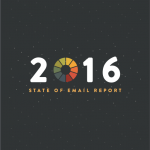2016 State of Email Marketing Report (Litmus)

In this post we echo the study offered by Litmus: 2016 State of Email Marketing Report. This report gathers the main changes in the sector in 2015 in order to go deeper into them and get information and action points to apply to Email Marketing this year 2016.
Litmus proposes 4 points to cover these changes:
New devices, applications and operating systems
Here we find important developments in terms of the role of email on new devices, the display and adaptation of email on different devices, improvements in email applications and updates to operating systems. Throughout 2015, different innovations are worth highlighting:
- Outlook for Android and iOSOutlook: an application created for professional use when we do not have our computers at our disposal. It is the adaptation of Outlook to the mobile device for a better and easier use of the tool.
- Apple Watchin April 2015, this device was created. It offers us the possibility, albeit with some limitations, to receive emails and read them without having to consult our mobile phone.
- AOL's Alto mail appThe webmail service is now available in a mobile version. Its main objective is to solve the problem of multiple inboxes. This application allows users to access different accounts in a single inbox and switch from one account to another with ease.
- Windows 10, universal Outlook app: The latest version of Windows, released in July 2015, came with a new Outlook application. This new app is universal, i.e. it looks the same on different devices (desktop, smartphones and tablets).
- iOS 9In September 2015, Apple released the latest version of the iOS system (iOS9), which includes new features of CSS and has introduced new changes that directly affect email marketers.
- Outlook 2016In September 2015, Microsoft released the latest version of Outlook, Outlook 2016. However, there have not been many changes compared to the previous versions. Emails are still created using Microsoft Word, which means that the support for HTML and CSS is still quite poor.
2. Updates and changes to email clients
Yahoo!, Gmail, Office and Dropbox are some of the email clients that have incorporated changes in 2015. First of all, Yahoo! mail has started using media queries in order to adapt to the mobile device (FINALLY!). Gmail on the other hand, is sticking to its guns. However, it has incorporated changes in the "Promotions" tab of the email, which has returned to text-only format. In addition, it has launched a new option that allows you to block users, once you have chosen this option... You will not receive any more emails from that user that bothers you so much!
Microsoft has many email applications. In order to unite all the features of the applications into one, Outlook.com is being replaced by Office 365. Finally, Dropbox has announced that it will close the email application it has offered until now.
3. Deliverability
With regard to the email deliverability, ISPs reveals that click-throughs do not affect email delivery process. This statement has caused many industry professionals to question some of the metrics used to measure user engagement. However, although click-through rate does not directly affect deliverability, it is important to keep this metric in mind because a drastic drop in click-through rate can be the cause of some kind of error, either in deliverability or in any of the processes involved in email marketing.
In addition to this revealing statement, in July 2015 Google launched gmail management tools (Gmail Postmaster Tools). These tools can be used to analyse large quantities of sent emails, including data on deliverability errors, reporting on SPAM and reputation. The main objective of these tools is clear: to receive the desired mail in our inbox and the SPAM in its rightful place.
4. Email Client Market Share
Over the course of 2015 the click-through rate on mobile devices has increased by 17%, so that it now accounts for 55% of opens, i.e, smartphone is the device with the highest percentage of openings. Followed by Webmail (email clients), which has decreased by 13% to 26% of opens. Finally, desktop opens have also decreased to only 19% of total opens.
In short, according to the study, Email Marketing is more powerful than ever. Industry data suggest that the Email Marketing ROI is the highest among the different Digital Marketing channels. It is also the preferred method for users.
To find out more about all these data, you can download the full report at this link.